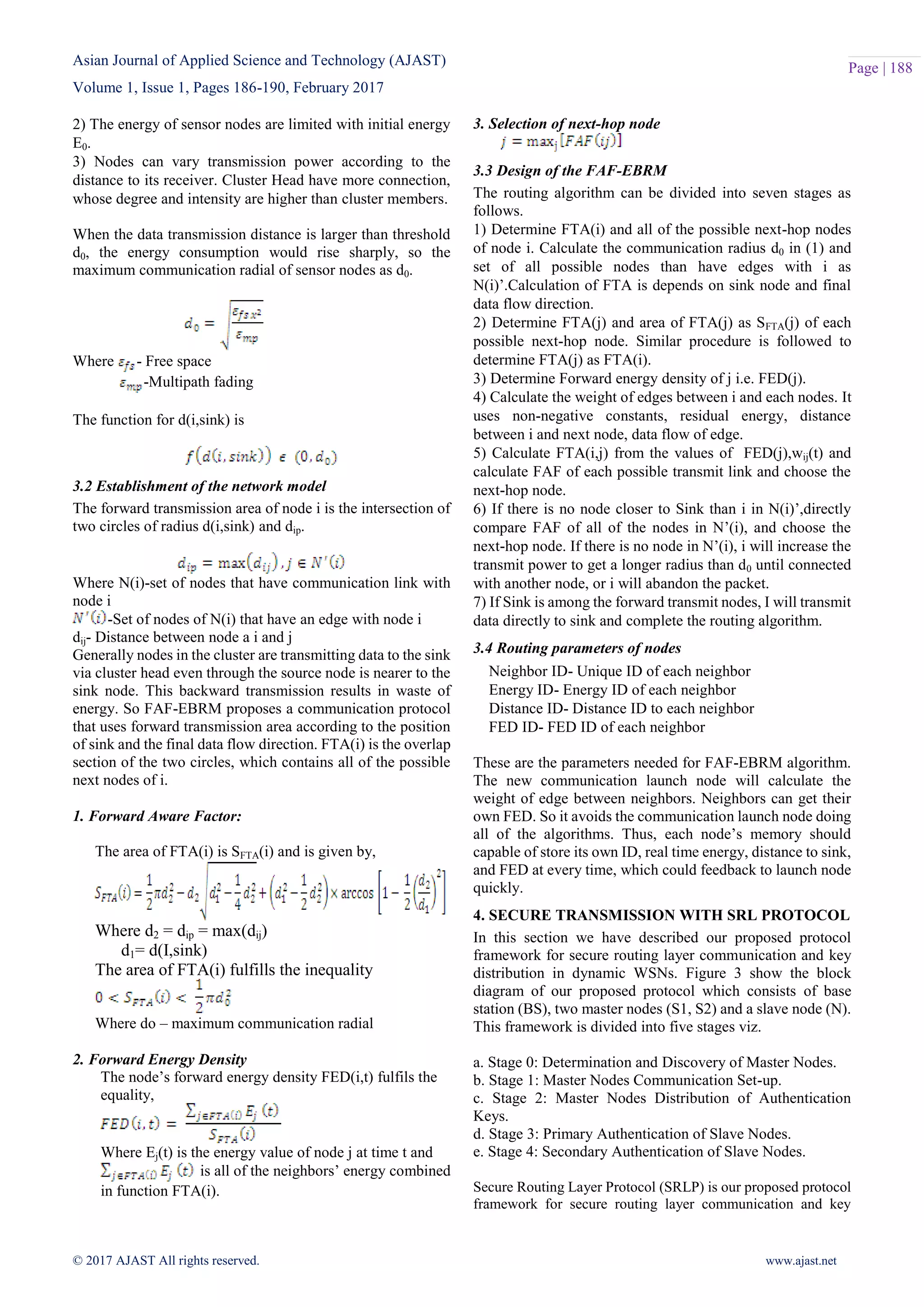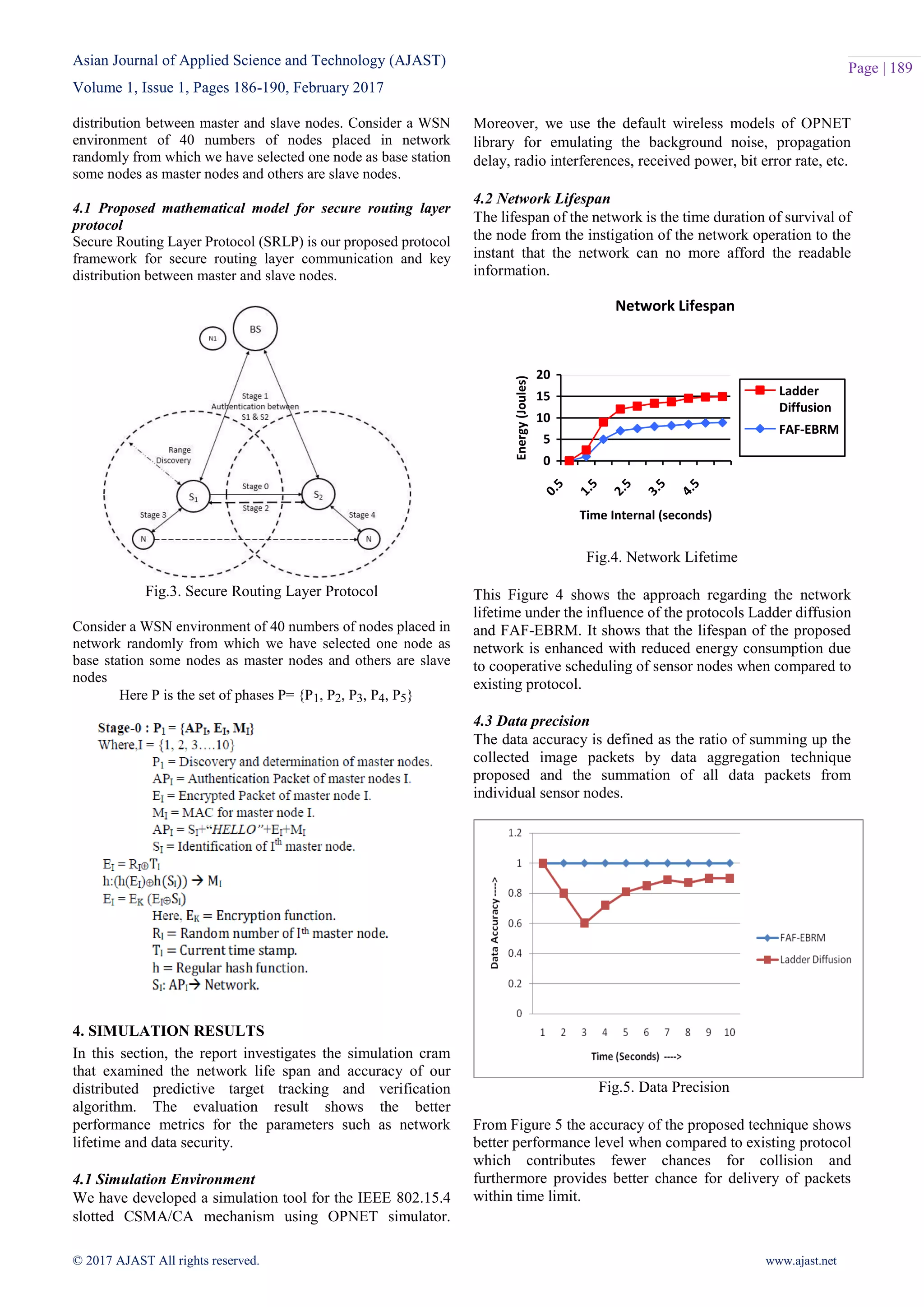The document discusses the challenges and techniques for secure data aggregation in wireless sensor networks (WSNs), emphasizing the importance of energy-efficient protocols due to the limitations of sensor nodes. It proposes a secure forward-aware factor-energy balanced routing method (FAF-EBRM) that enhances energy management and data transmission reliability, alongside a secure routing layer protocol (SRLP) for secure communication. Simulation results indicate that the proposed solutions improve network lifespan and data accuracy compared to existing methods.
![Asian Journal of Applied Science and Technology (AJAST) Volume 1, Issue 1, Pages 186-190, February 2017 © 2017 AJAST All rights reserved. www.ajast.net Page | 186 Secured Data Aggregation using SRL Protocol for Wireless Sensor Networks V.Vinu Raja1 and Mohammed Irfan Lebbai2 1 Department of Electronics and Communication Engineering, Sri Eshwar College of Engineering, Coimbatore, India. Email: vinurajaa@gmail.com 2 Network Administrator, Tata Consultancy Services, Chennai, India. Email: mohamed.irfan1@tcs.com Article Received: 11 February 2017 Article Accepted: 26 February 2017 Article Published: 28 February 2017 1. INTRODUCTION Holocene technological debuts made in electronics and wireless communications have fostered the enlargement of wireless sensor networks (WSNs). A WSN is a self-organization wireless network system typically dwells of many small, low cost, low-power communication devices called sensor nodes. Each sensor node has restricted on-board processing, inadequate storage and radio capabilities. Owing to the limited communication ability and Non-rechargeable energy supply (e.g. battery), WSNs have rigorous requirements about power consumption. Therefore energy-efficient protocols are vital to save energy and protract network lifetime. Micro sensors are deployed to monitor the sensing field and collect information from physical or environmental condition and to co-operatively pass the collected data through the network to a main location. Traditionally there are two approaches to accomplish the data collection task: Single-hop and Multi-hop forwarding. In single hop wireless communication (Direct), the sensor nodes upload data directly to the sink, which may result in long communication distances and degrade the energy efficiency of sensor nodes. But in multi-hop forwarding, data are transferred from the nodes to the sink through multiple relays, and thus communication distance is reduced. However, since nodes closer to the sink have a much heavier forwarding load, their energy may be exhausted quickly, which degrades the network performance. Clustering is an effective technique to reduce energy consumption in WSNs. In clustering algorithm, a number of nodes in a network will be chosen as the cluster heads (CHs) and the remaining nodes will be regarded as the cluster members (CMs). CMs will form connections with the CHs. A head node will collect data from its CMs and the actual data transmitted to the base station (BS).In WSN clustered hierarchical routing protocols, at times CMs are closer to the sink than CH, but it should transmit data to CH earliest. This backward transmission result in waste of energy. 2. RELATED WORK 2.1 SECURE AGGREGATION TECHNIQUES Several secure aggregation algorithms have been proposed assuming that the base station is the barely aggregator node in the network [8]–[6]. It is not straightforward to extend these works for verifying in-network aggregation unless we direct each node to send an authentication message to the base station, which is a very expensive solution. A tree-based verification algorithm was designed in [2]–[10] by which the base station can detect if the final aggregate, Count or Sum, is falsified. The paper is unable to extend this idea for verifying a synopsis because the synopsis computation is duplicate-insensitive. A verification algorithm for computing Count and Sum within the synopsis diffusion approach was designed in [6]. In addition, algorithm provides extensive theoretical analysis to find the best tradeoffs between the security and communication overhead. Recently, a few novel protocols have been proposed for “secure outsourced aggregation” [5]; however, these algorithms are not designed for WSNs. 2.2 LOW ENERGY ADAPTIVE CLUSTERING HIERARCHY (LEACH) PROTOCOL In LEACH, all the nodes in a network organize themselves into local clusters. The protocol is divided into a setup phase when the clusters are organized and a steady state phase when CH receive data from all the CMs, perform data aggregation and transmit data to the remote base station. The operation of LEACH in time slots is illustrated in Figure1. ABSTRACT In wireless sensor network energy cutback is considered as a principle intensive challenge which is studied largely in the Wireless Sensor Networks (WSN) literature. Wireless Sensor Networks (WSNs) are pertinent in numerous arenas where WSNs may be used for sensing, ciphering, and communication elements that give a user or administrator the ability to instrument, observe, and retort to events and phenomena in a specific environment. But sensor devices are resource curbed, positioned in an open and unattended environment, different types of attacks and conventional techniques against these attacks are not desirable due to the resource constrained nature of these kinds of networks. An energy-balanced routing method based on forward-aware factor (FAF-EBRM) in which the next-hop node is elected according to the awareness of link weight and forward energy density. FAF-EBRM is compared with Ladder Diffusion Algorithm, which balances the energy utilization, sustain the function era and guarantees high QoS of WSN. The FAF-EBRM is proposed with Secure Routing Layer (SRL) Protocol which ensures that the secure data transmission is achieved without releasing private sensor readings and without introducing significant overhead on the battery-limited sensors. Keywords: Energy balance routing, forward-aware factor, SPIN algorithm, Security and wireless sensor networks.](https://image.slidesharecdn.com/ajast39-170318200053/75/Secured-Data-Aggregation-using-SRL-Protocol-for-Wireless-Sensor-Networks-1-2048.jpg)



![Asian Journal of Applied Science and Technology (AJAST) Volume 1, Issue 1, Pages 186-190, February 2017 © 2017 AJAST All rights reserved. www.ajast.net Page | 190 5. CONCLUSION In wireless sensor networks, sensor nodes are usually resource inhibited and battery-limited. And transmission is much more energy consuming than computation. Therefore, communication overhead is an important issue in wireless sensor networks. Data aggregation can diminish the communication overhead and energy consumption, thus extending the lifetime of wireless sensor networks. In this paper, the FAF-EBRM Algorithm and Secure Routing Layer Protocol is implemented. In addition, to make sure the safety and reliability of data transmission, the algorithm provides back-up routes to avoid wasted power consumption and processing time when rebuilding the routing table in case of a sensor node is missing. The result shows that the power consumption and communication overhead is decreased with secure transmission in the network. The experimental results can be extended to transmit the multimedia messages from sensor nodes that exchange audio and video signals showing how the proposed solution can be tailored to many application domains. In Wireless Multimedia Sensor Networks, battery life and the resource reticence plays a vital role. Transmission of image packets also results in more energy consumption. The paper proposes an algorithm for a mobile target tracking surveillance sensor network is supported by sleep docketing technique. The main spotlight of this technique is to optimize the recital metrics such as network lifespan, energy consumption and data security. By applying sleep scheduling method and reducing the efforts of the working nodes energy efficiency can be made superior. Data latency is another significant issue in wireless multimedia sensor applications, in future work the research will be preceded with alternative technique in exploring the communication overhead problem. REFERENCES [1] V.Vinu Raja, S.Chinnaiya, “Secure Data Aggregation using Ladder Diffusion Algorithm in Wireless Sensor Networks”, International Journal of Emerging Trends in Electrical and Electronics (IJETEE – ISSN: 2320-9569) Vol. 3, Issue. 1, May-2013. [2] Buttyan, L, P. Schaffer, and I. Vajda, “Resilient aggregation with attack detection in sensor networks,” in Proc. 2nd IEEE Workshop Sensor Networks and Systems for Pervasive Computing, 2006. [3] Chalermek Intanagonwiwat, Ramesh Govindan, Deborah Estrin, John Heidemann, Fabio Silva, Directed diffusion for wireless sensor networking, IEEE ACM Transactions on Networking 11 (February) (2003) 2–16. [4] I.F. Akyildiz, T. Melodia, and K.R. Chowdury, ―Wireless Multimedia Sensor Networks: A Survey,‖ IEEE Wireless Comm., vol. 14, no. 6, pp. 1339-1352, Dec. 2007. [5] G. Anastasi, M. Conti, M. D. Francesco, and A. Passarella, ―Energy conservation in wireless sensor networks: A survey, Ad Hoc Networks, vol. 7, no. 3, pp. 537-568, 2009. [6] A. Aziz, Y. Sekercioglu, P. Fitzpatrick, and M. Ivanovich, ―A Survey on Distributed Topology Control Techniques for Extending the Lifetime of Battery Powered Wireless Sensor Networks,‖ IEEE Commun. Surveys Tuts., vol. PP, no. 99, pp. 1–24, 2012. [7] S. S. Chatterjea, T. Nieberg, N. Meratnia, and P. Havinga, ―A distributed and self-organizing scheduling algorithm for energy- efficient data aggregation in wireless sensor networks,‖ ACM Trans.Sen. Netw., vol. 4, no. 4, pp. 1-41, 2008. [8] J. Denga, Y. S. Hanb, W. B. Heinzelmanc, and P. K. Varshney,―Balanced-energy sleep scheduling scheme for jigh density cluster-based sensor networks,‖ in computer communications: special issue on ASWN04, vol. 28, 2005, pp. 1631-1642. [9] Y. Yang, X. Wang, S. Zhu, and G. Cao, “SDAP: A secure hop-by-hop data aggregation protocol for sensor networks,” in Proc. Seventh ACM Int. Symp. Mobile Ad Hoc Networking and Computing (MobiHoc), 2006. [10] Yu, H, “Secure and highly-available aggregation queries in large-scale sensor networks via set sampling,” in Proc. Int. Conf. Information Processing in Sensor Networks, 2009. AUTHOR BIOGRAPHIES V.Vinu Raja received his B.E and M.E Degrees in Electronics & Communication Engineering in the year 2009 in Vinayaka Missions University, Salem, Tamilnadu, India and M.E in Applied Electronics in the year 2013 in Anna University, Coimbatore, Tamilnadu, India.. He is currently working as an Assistant Professor in Sri Eshwar College of engineering, Coimbatore. His research area includes Wireless Sensor Networking, Multimedia security, Ethical hacking etc. He is a life time member of ISTE. Mohammed Irfan Lebbai currently working as a Network administrator in Tata Consultancy Services, Chennai. He is expert in Networking maintence and fixing bugs in realtime Networking environment.](https://image.slidesharecdn.com/ajast39-170318200053/75/Secured-Data-Aggregation-using-SRL-Protocol-for-Wireless-Sensor-Networks-5-2048.jpg)